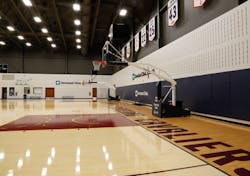Cleveland Cavaliers light NBA practice facility with GE Albeo LED high-bay fixtures (VIDEO)
The 17,000-ft2 practice floor is lit with more than 70 GE Lighting Albeo fixtures while the team has also installed GE Lumination EL Series luminaires in the locker room.
While the Cleveland Cavaliers push toward the US National Basketball Association (NBA) playoffs as the hottest team in the Association, the players spend their practice time working under new LED-based sports lighting from GE Lighting's Albeo brand. The new lighting will save considerable energy while also offering the instant-on capabilities sought by the team. The retrofit of the player development center, called the Cleveland Clinic Courts, also included installation of GE Lighting Lumination EL Series fixtures in the locker room.
The team was led to the retrofit by the long warm-up time of the older metal-halide (MH) sports lighting. "I was walking across the court with our general manager not long ago when, lo and behold, we lost power," said David Painter, senior manager of practice facilities for the team. "The only lights that came back up were the LEDs, and he looked at me and he said, ‘DP, we've got to get this done. It's a no-brainer.'"
The main practice room in the 17,000-ft2 facility includes two full-size courts. So the team wanted granular control of the sports lighting, along with the instant-on capability in part because of the need to record practice sessions. "We needed instant-on ability from our new lights to get the team back in action as fast as possible," said Painter. "We also shoot a lot of video and host media events here too, so it's important our gymnasium looks its best and brightest at all times."
The team turned to manufacturer representative Myriad Energy for help in selecting products for the retrofit project. The firm recommended products from Albeo for the project. The new sports lighting is rated for 100,000 hours of life with no maintenance.
It's no surprise that LED lighting is acceptable for a professional sports team at this point as a number of stadiums and arenas now use LED-based lighting. Just recently we covered an LED sports lighting project at the Major League Baseball (MLB) Seattle Mariner's Safeco Field. Moreover, the National Football League (NFL) Super Bowl was played under LED lighting this year.
The Cavaliers' practice facility is well lit by the new sports lighting as is evident in the nearby photo and the video below. But the main benefits are the instant controllability, greatly reduced maintenance, and lower energy usage.
Painter said replacing burned-out MH lamps was a significant problem. "We have 50-ft ceilings that pitch back to 36 ft. We had to invent a pulley system just to change the old lights," said Painter. “Now there's no issue with ballasts or replacing bulbs, which may be the thing I'm most excited about, personally."
The team also expects to save $14,000 per year in energy costs from the combination of lighting and HVAC systems. That number could increase as the team installs controls. The lighting is already dimmable so energy usage is minimized when the courts aren’t in use. But the team is in the process of installing controls that will allow more granular dimming for portions of the practice-court area.
The players, meanwhile, are enjoying better, and more stylish lighting in the locker room as well. The EL Series luminaires use GE's Intrinsx optical light guide technology. The fixtures have planar optical blades that extend from the fixture body vertically toward the floor.
"Cleveland Clinic Courts is among the most technologically advanced team development facilities in pro sports — if not the best — and additions like these new lights will keep it that way," said Painter. We will see in the coming months if the practice-facility lighting, and perhaps the team's reacquisition of LeBron James, deliver the fans the long sought championship.

Maury Wright | Editor in Chief
Maury Wright is an electronics engineer turned technology journalist, who has focused specifically on the LED & Lighting industry for the past decade. Wright first wrote for LEDs Magazine as a contractor in 2010, and took over as Editor-in-Chief in 2012. He has broad experience in technology areas ranging from microprocessors to digital media to wireless networks that he gained over 30 years in the trade press. Wright has experience running global editorial operations, such as during his tenure as worldwide editorial director of EDN Magazine, and has been instrumental in launching publication websites going back to the earliest days of the Internet. Wright has won numerous industry awards, including multiple ASBPE national awards for B2B journalism excellence, and has received finalist recognition for LEDs Magazine in the FOLIO Eddie Awards. He received a BS in electrical engineering from Auburn University.





